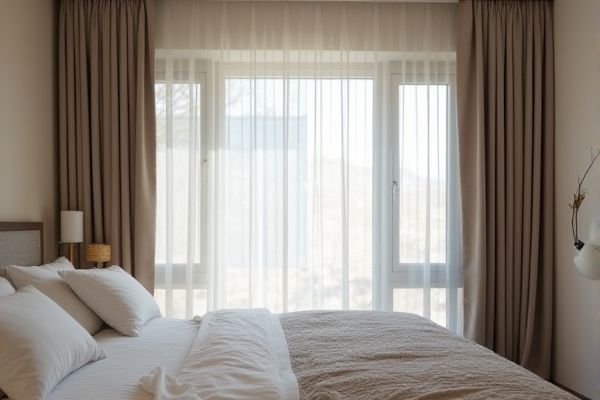
Bed curtains provide privacy and create a cozy, enclosed space around your sleeping area, while window curtains primarily control light, enhance privacy, and contribute to room decor by framing the windows. Discover how choosing between bed curtains and window curtains can transform your living space and improve your comfort in the rest of this article.
Table of Comparison
| Feature | Bed Curtain | Window Curtain |
|---|---|---|
| Purpose | Provides privacy and darkness around the bed | Blocks light and provides privacy for windows |
| Material | Often thick, blackout fabrics or breathable mesh | Varies from sheer to heavy fabrics |
| Installation | Suspended from bed frames or ceiling rods | Mounted on window rods or tracks |
| Size | Custom fit to bed dimensions | Fits standard window measurements |
| Functionality | Creates a cozy, enclosed sleeping area | Controls natural light and enhances window aesthetics |
| Usage | Common in dorms, shared rooms, or minimalist bedrooms | Used in all types of rooms for light and privacy control |
Introduction to Bed Curtains and Window Curtains
Bed curtains and window curtains serve distinct purposes in interior design and functionality; bed curtains are typically used to create privacy and block light around a sleeping area, often suspended from a frame or canopy. Window curtains primarily function to control natural light, enhance room aesthetics, and provide privacy for windows. Both types are available in various fabrics, colors, and styles to complement different decor themes.
Key Differences Between Bed Curtains and Window Curtains
Bed curtains provide privacy and create a cozy sleeping environment by enclosing the bed area, often made from thicker fabrics to block light and noise, while window curtains primarily function to control natural light and enhance room decor with various materials and styles. Bed curtains are typically designed for interior use around beds, particularly in shared or multi-functional spaces, whereas window curtains are installed on windows to offer sun protection, insulation, and aesthetic appeal. The key differences lie in their placement, functional purpose, and fabric choice, with bed curtains emphasizing privacy and comfort, and window curtains focusing on light management and external visibility.
Material Choices: Bed Curtain vs. Window Curtain
Bed curtains are typically crafted from heavier, opaque materials such as velvet or thick cotton to provide privacy and block light effectively around sleeping areas. Window curtains, conversely, utilize a broader range of fabrics, including lightweight linens, sheer polyester, or blends that balance aesthetic appeal with functional light control. The choice of material for each curtain type directly influences room ambiance, privacy levels, and light filtration, making material selection a critical factor in interior design.
Style and Design Variations
Bed curtains often feature thicker fabrics and blackout materials to enhance privacy and create a cozy, enclosed space, offering styles like canopy drapes or tailored panels that complement bedroom aesthetics. Window curtains prioritize light control and room ambiance, employing diverse patterns, sheer textiles, and decorative designs to enhance interior decor while allowing adjustable natural light. Both types present wide-ranging options--from minimalist, solid colors to intricate prints--tailored for functional use and visual appeal in their respective settings.
Privacy and Functionality Comparison
Bed curtains provide enhanced privacy by creating a personal enclosed space, ideal for shared rooms or dormitories, while window curtains primarily block or filter external light and visibility from outside. In terms of functionality, bed curtains offer a sense of security and can reduce noise, whereas window curtains focus on controlling room ambiance through light management and thermal insulation. Your choice depends on whether privacy within the room or external light control is more important for your living space.
Installation and Maintenance
Bed curtains typically require a sturdy frame or canopy installation that can support fabric weight and remain stable, while window curtains need precise mounting hardware like rods or tracks fitted to window dimensions for smooth operation. Maintenance of bed curtains often involves spot cleaning or removable fabric that can be washed to manage dust, whereas window curtains demand regular dusting, occasional washing, and attention to sun exposure effects to preserve color and fabric integrity. Your choice should consider installation complexity and the frequency of cleaning based on room use and environmental factors.
Room Ambience and Light Control
Bed curtains create a cozy and private sleeping space by enclosing your bed, enhancing room ambience with a sense of intimacy and warmth. Window curtains primarily control natural light entering the room, allowing you to adjust brightness and maintain privacy while affecting overall room atmosphere. Choosing between bed curtains and window curtains depends on your priorities for light control and the desired ambiance within your living space.
Cost Considerations
Bed curtains generally involve higher costs due to custom sizing, specialized fabrics, and installation hardware designed for privacy and sleep enhancement. Window curtains vary widely in price based on material, size, and style, with options ranging from budget-friendly polyester to premium silk. Choosing between bed and window curtains depends on budget allocation, intended use, and desired aesthetic impact in the living space.
Popular Trends in Bed and Window Curtains
Popular trends in bed curtains emphasize privacy and aesthetic appeal, featuring lightweight fabrics and neutral colors to create cozy, intimate sleeping nooks. Window curtains are trending towards multifunctional designs, such as blackout curtains combined with sheer layers to balance light control and style. Your choice should consider current materials like eco-friendly linen for beds and thermal insulated fabrics for windows, blending modern functionality with elegant decor.
Choosing the Right Curtain for Your Needs
Bed curtains provide privacy and create a cozy, enclosed sleeping space, ideal for shared rooms or dormitories, while window curtains control light, protect against UV rays, and enhance home aesthetics. Consider the functionality you require: if privacy and sleep environment are priorities, bed curtains are the better choice; for decoration, insulation, and light management, window curtains serve best. Material, size, and mounting options should align with your specific needs for optimal comfort and style.
 homyna.com
homyna.com